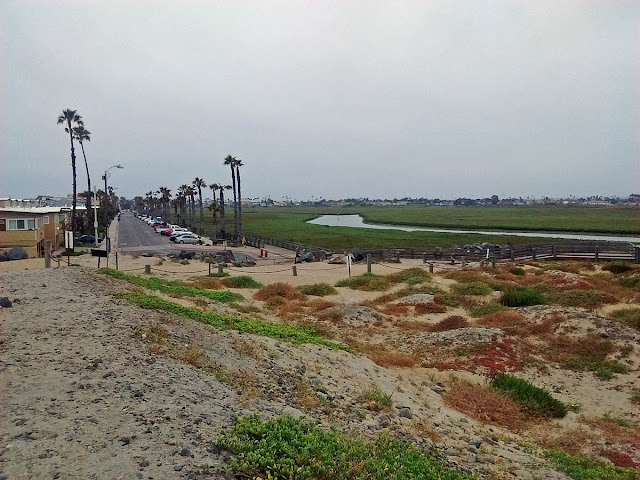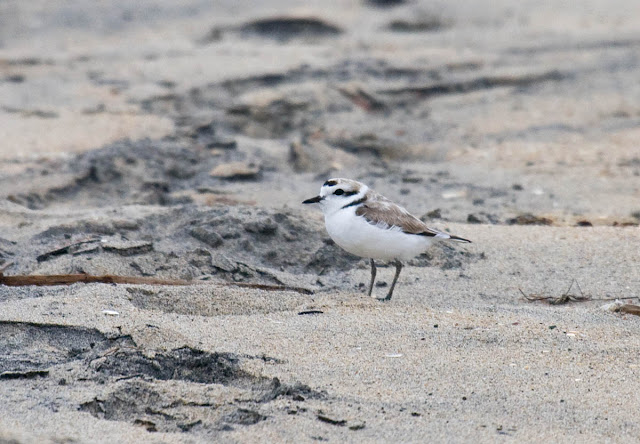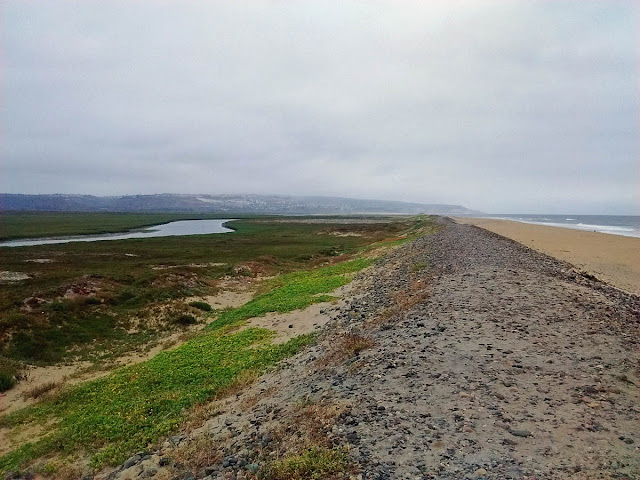When birders refer to the Tijuana River mouth, they are likely speaking of this location--the north side of the river reached via the south end of Seacoast Drive in Imperial Beach. On the other hand, perhaps they are speaking of the south side of the river at Border Field State Park--so make sure if you are chasing a rare bird.
Load 1699 Seacoast Drive, Imperial Beach into your GPS map navigation program. Find a free parking space as near to the end as you can. Get out and walk the dike southward.
This dike/beach walk isn't really a scenic walk, and there aren't a lot of different species. However, it is a place to go to search for specific birds at specific times of the year. I recommend a scope to view seabirds and also to enlarge the shorebirds, terns, and egrets you may see at quite a distance on the Oneonta Slough and later at the Tijuana River mouth itself.
 |
| The south end of Seacoast Drive in Imperial Beach looking northward across Oneonta Slough. At the horizon on the right is the Tijuana Slough National Wildlife Refuge visitor center and start of the McCoy Trail--a site for another time. |
The photo above is looking north at the parking area. The photo below is looking south following the dike trail. Though the small cobble is rocky and uneven, it is slightly easier to walk than the loose sand beach. Don't worry, you'll get to do both.
It is exactly 1 mile from the parking area to the river mouth. The first 1/2 mile is on this dike. It disappears and then the final 1/2 mile is on the beach sand.
From the dike look east along the slough for egrets and herons--Snowy Egrets are abundant; Great Egrets, Great Blue Herons, and Little Blue Herons are frequent; Yellow-crowned Night-Heron is a specialty and may be slightly more expected than Black-crowned Night-Heron here; and Reddish Egret is a regular rarity. Perhaps a Ridgway's Rail will venture out of the marsh vegetation for a moment or give its loud grunting series of calls.
You can see for yourself in the photo above that shorebirds would be difficult to identify along the slough with only binoculars (you must stay on the dike or beach). Willets, Long-billed Curlews, Marbled Godwits, Whimbrels, American Avocets, and Black-necked Stilts are identifiable, but you'll likely need a scope for smaller sandpipers and plovers.
Stop periodically to scan the ocean to the west for Surf Scoters or rarer kin. You may be able to see Brown Boobies from shore here though, again, a scope to look out 2-3 miles takes your vision out where it needs to be for these birds, and perhaps jaegers or shearwaters in fall.
You may hear Western Meadowlarks singing and there are Horned Larks on the dike and behind the foredune, such as it is. Look for Northern Harriers (they nest here) or other hawks, especially in winter, working the slough.
After the rocky dike dissolves into the beach you are at the sandy breeding grounds of Least Terns and Snowy Plovers. In summer the breeding area is roped off, but you can still walk around it. Both species breed here from April to July, but you may be able to find the Snowy Plovers on the adjacent beach all year. I've found this location to be the most reliable place to find Snowy Plovers in the county, but maybe I just don't know where else to look--others find them on many other beaches.
 |
| Least Tern |
 |
| Snowy Plover |
 |
| Tijuana River mouth looking south toward Tijuana, Mexico on the hill. |
 |
| Tijuana River mouth looking southwest toward Islas Coronados offshore. |
Once you reach the mouth of the Tijuana River you may be closer to shorebirds again. Pelicans, Heermann's Gulls, and cormorants roost and feed at the mouth (as above photo). Elegant Terns can number into the thousands in summer.
 |
| Brown Pelicans and friends |
 |
| Heermann's Gull |
There are two other birds of note here to look for. Black Skimmers may roost and fly around in the lower river mouth. Gull-billed Terns may work the slough like the Forster's Terns, but are larger, with a thick black bill. Elegant Terns fly over, commuting from just offshore to the south end of San Diego Bay, but the Gull-billed fly along the river channel and out to sea--not quite as high and direct. And Caspian Terns may roost.
 |
| Gull-billed Tern |
 |
| Forster's Tern |
 |
| Snowy Plover |













No comments:
Post a Comment
I really want to hear from you! I've changed settings (again) in order to try to make commenting easier without opening it up to spammers. Please note, however, that comments to posts older than 14 days will be moderated. Thank you.